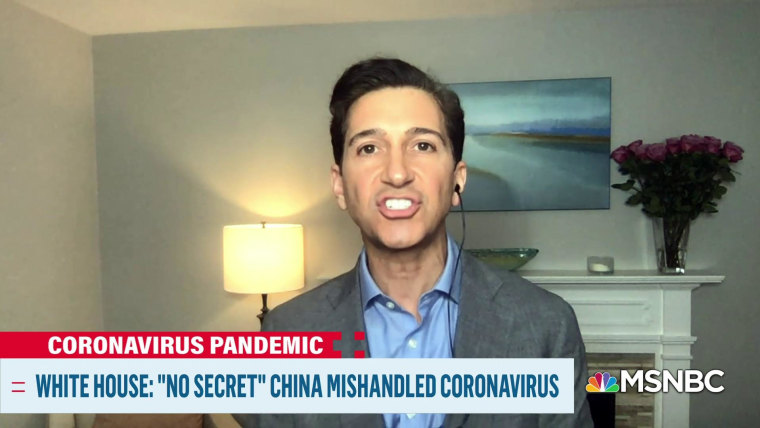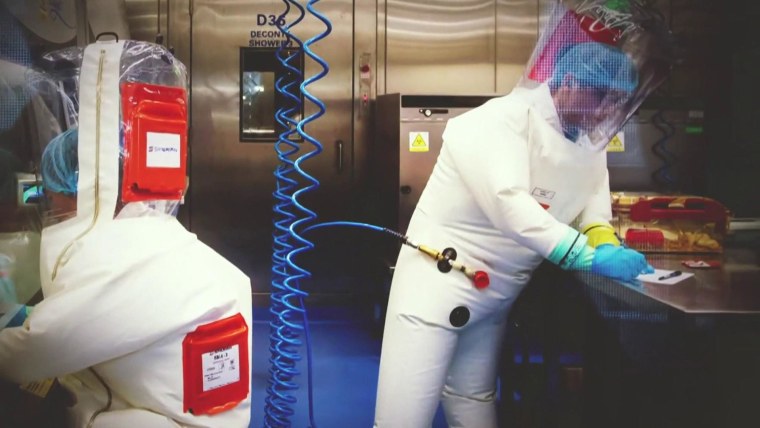WASHINGTON — There has been a barrage of contradictory claims in recent days about how American officials believe coronavirus emerged from the Chinese city of Wuhan, what evidence they have, and when President Donald Trump was first briefed about it.
Here is what we actually know:
When was Trump first briefed on the intel about coronavirus?
As NBC News has reported, U.S. intelligence agencies first detected signs of a health crisis in Wuhan in November, and began producing intelligence reports on the issue in December. Intelligence reports first appeared in the president's briefing book, known as the President's Daily Brief, in early January, according to our reporting. The PDB is written for the president but it also goes to certain cabinet officials and top advisers.
The National Security Council began meeting about coronavirus in early January, according to NBC News reporting.
But according to multiple officials, Trump rarely if ever reads his written intelligence product. On Sunday, Trump said he was first briefed Jan. 23.
"On January 23, I was told that there could be a virus coming in but it was of no real import. In other words it wasn't, 'Oh we've got to do something, we've got to do something.' It was a brief conversation and it was only on January 23," Trump said during a Fox News town hall Sunday.
Did the virus really emerge accidentally from a Chinese lab?
Let our news meet your inbox. The news and stories that matters, delivered weekday mornings.
Despite Trump's comment Thursday that he has seen information that gives him high confidence that the coronavirus outbreak was the result of an accidental release from a Wuhan laboratory, U.S. intelligence officials tell NBC News they have made no such assessment. There is no "smoking gun" evidence pointing them in that direction, they say, and there may never be.
Intelligence officials stand by the public statement put out by the Office of the Director of National Intelligence Thursday, which said that the intelligence community has concluded that the virus was not man-made, but had reached no conclusion about whether it emerged accidentally from a lab or transmitted to humans through animals.
NBC News reported last week that the White House has tasked the intelligence community with investigating this and other questions about the origin of the virus, the extent to which China covered it up, and whether the World Health Organization was complicit in that cover-up. Some critics have raised the concern that the White House is pushing the intel agencies to validate a conclusion that helps them politically, by distracting attention from the question of whether they acted soon enough. China and the WHO deny that they were less than forthcoming and China says the virus could not have come from one of its labs.
Secretary of State Mike Pompeo said on ABC Sunday that "there is enormous evidence … I can tell you that there is a significant amount of evidence that this came from that laboratory in Wuhan." But he declined to detail that evidence, as did Trump when asked about it.
Two White House officials told NBC News that by saying he'd seen convincing evidence, Trump wasn't saying he'd seen an intelligence assessment.
Scientists and virologists say a far more likely explanation of how the virus emerged is natural transmission from animals to people. But experts and U.S. officials say there is a good deal of circumstantial evidence pointing to an accidental release. No one has credibly suggested the virus was engineered by humans. Pompeo said he accepted the scientific consensus that the virus was naturally occurring.
Two labs in Wuhan were studying coronaviruses, experts tell NBC News: the Wuhan Institute of Virology (WIV) and the Wuhan Center for Disease Control and Prevention, shorthanded as the Wuhan CDC. Researchers from both facilities collected the virus samples from bats in caves. The goal of this research was to learn more about the family of viruses that had already been proven lethal to humans in the 2002 SARS outbreak.
Less is known about the Wuhan CDC, which is located a short distance from the Wuhan wet market where officials first said the virus emerged. Much attention has been focused on the WIV, which has a Biosafety Level 4 section where scientists work on the most dangerous pathogens. It should be noted, however, that coronaviruses are not deemed dangerous enough to require BSL-4 safety procedures. They are in a BSL-3 category, requiring less rigorous procedures.
In the accidental release scenario, a worker at one of the labs could have become infected and transmitted the virus to others. Those who suspect such a lab release point to the following:
- A Jan. 24 study published in the Lancet medical journal found that three of the first four cases — including the first known case — did not provide a documented link to the Wuhan wet market.
- The bats that carry the family of coronaviruses linked to this new strain are not found within 100 miles of Wuhan — but they were studied in both labs.
- Photos and videos have emerged of researchers at both labs collecting samples from bats without wearing protective gear, which experts say poses a risk of human infection
- A U.S. State Department expert who visited WIV in 2018 wrote in a cable reported by the Washington Post: "During interactions with scientists at the WIV laboratory, (US diplomats) noted the new lab has a serious shortage of appropriately trained technicians and investigators needed to safely operate this high-containment laboratory."
- According to intelligence committee member Sen. Tom Cotton, R.-Ark., the Chinese military posted its top epidemiologist to the WIV in January.
- The Shanghai laboratory where researchers published the world's first genome sequence of the novel coronavirus was shut down Jan. 12, according to the South China Morning Post.
- According to U.S. intelligence assessments, including one published by DHS and reviewed by NBC News, the Chinese government initially covered up the severity of the outbreak. Government officials threatened doctors who warned their colleagues about the virus, were not candid about human-to-human transmission and still have not provided virus samples to researchers.
Despite all that, most scientists and researchers believe natural animal to human transmission is the most likely scenario.
Peter Daszak, a virus expert who has visited one of the Wuhan labs as part of a U.S.-funded program, told NBC News that millions of people in China are infected each year by coronaviruses from animals. Most of those infections are not life threatening.
"There's just an incredible volume of traffic between wildlife and people," he said.
He added that the WIV rarely worked with live viruses and generally practiced sound safety procedures.
"I've been in hundreds of labs and I know a good lab when I see one," he said. "These guys are good."
"really" - Google News
May 05, 2020 at 01:35AM
https://ift.tt/2W3e9kg
Did the coronavirus really escape from a Chinese lab? Here's what we know - NBCNews.com
"really" - Google News
https://ift.tt/3b3YJ3H
https://ift.tt/35qAk7d
Bagikan Berita Ini



















0 Response to "Did the coronavirus really escape from a Chinese lab? Here's what we know - NBCNews.com"
Post a Comment